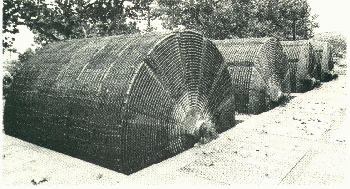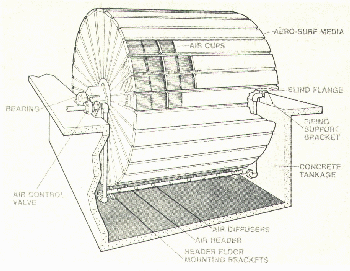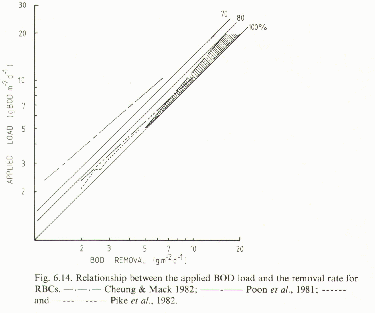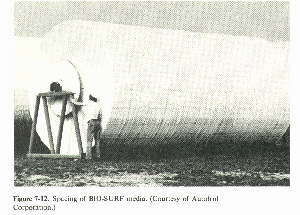Rotating Biological Contactor (RBC) - 2...
Rotating biological contactors is a remediation technology used in the secondary treatment of wastewater. This
technology involves allowing wastewater to come in contact with a biological medium in order to facilitate the removal
of contaminants. One of the earliest reports of the treatment of wastewater by a contact process involving partially submerged rotating plates was given in 1929. However, it was not until 1965 that a commercially available process became available. There are several different designs now available, but in its simplest form a rotary biological contactor (RBC) consists of a series of discs mounted on a shaft which is driven so that the discs rotate at right angles to the flow of settled sewage. The discs are usually made of plastic (polythene, PVC, expanded polystyrene) and are contained in a trough
so that about 40 percent of their area is immersed. The discs are arranged in groups or packs with baffles between each
group to minimize surging or short-circuiting. With small units the trough is covered and large units are often housed
within buildings. This is to reduce the effect of weather on the active biofilm which becomes attached to the disc
surfaces.

RBC units are usually installed in a concrete tank so that the surface of the wastewater passing through the tank almost reaches the shaft. This means that about 40% of the total surface area of the disks are always submereged. The shaft continually rotates at 1 to 2 rpm, and a layer of biological growth 2 to 4 mm thick is soon established on the wetted
surface of each disk. The biological growth that becomes attached to the disks assimilates the organic materials in the wastewater. Aeration is provided by the rotating action, which exposes the disks to the air after contacting them with
the wastewater. Excess biomass is sheared off in the tank, where the rotating action of the disks maintain the solids in suspension. Eventually, the flow of the wastewater carries these solids out of the system and into a clarifier, where
they are separated. By arranging several sets of disks in series, it is possible to achieve a high degree of organic
removal and nitrification.

One of the rotating biological contactor systems available commercially is the BIO-SURF process. The fundamental module of the BIO-SURF process is a 25-ft-long steel shaft supporting an assembly of 12-ft-diameter polyethylene disks. The BIO-SURF media consists of alternating flat and corrugated sheets of polyethylene. Such an arrangement provides a much larger surface area than does a simple flat disk. Selective gaps between groups of disks along a single shaft provide a series of treatment stages for small flows. However, in large installations, a 25-ft module is used as a single stage itself. Generally, a 25-ft by 12-ft-diameter module contains about 104,000 ft2 of total surface area. Each of these modules is driven by a 5-hp motor. The BIO-SURF process can be designed to produce an effluent BOD5 of 10 mg/l. The composition of effluents between 10 and 20 mg/l BOD5 generally consists of approximately 1/3 soluble and 2/3 insoluble BOD5.
Advantages Offered by Rotating Biological Contactors...
1. Short contact periods are required because of the large active surface
2. They are capable of handling a wide range of flows
3. Sloughed biomass generally has good settling characteristics and can easily be separated from waste stream
4. Operating costs are low because little skill is required in plant operation
5. Short retention time
6. Low power requirements
7. Elimination of the channelling to which conventional percolators are susceptible
8. Low sludge production and excellent process control

Disadvantages of Rotating Biological Contactors...
1. Requirement for covering RBC units in northern climates to protect against freezing
2. Shaft bearings and mechanical drive units require frequent maintenance
Performance of Biological Contactors...
The performance of RBC systems depends on the temperature, the concentration of the pollutants, and the rate at which the treatment is expected to proceed. Studies have shown that, in terms of BOD removal, there is a critical hydraulic retention time of 3 hours and that any further increase in the retention results in little or no improvement in performances. It has also been shown that as the applied organic loading rate increases above about 5, the deviation from 100 percent efficiency becomes more pronounced. The performance characteristics of RBCs are frequently expressed as applied loading/removal rate curves. This figure shows the geometric relationships used for 70, 80 and 100 percent efficiencies. Superimposed upon these are data from other performance studies. These show that the usual performance efficiency is better than 80 percent.

The oxidation of ammonia is also an important feature in assessing the performance of any biological reactor. The degree of nitrification that is achieved by RBCs is dependent on several factors. Studies have shown that the removal of ammoniacal nitrogen is related to the hydraulic loading rate, and it has been reported that full nitrification can only be achieved
when the organic loading rate is less than 5 g BOD / m 2 . day. Some work has highlighted two aspects of nitrification by RBCs, showing that the process was oxygen limited in summer months and that a good BOD removal was
necessary prior to nitrification. Failure to achieve this meant that the amount of disc surface available for colonization
by the nitrifying species was significantly restricted.







